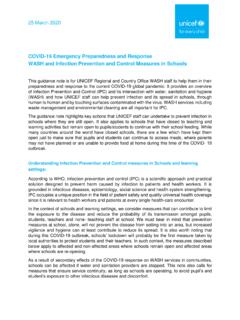Transcription of Gender and COVID -19 - World Health Organization
1 -1- Gender and COVID -19 Advocacy brief 14 May 2020 Background Pandemics and outbreaks have differential impacts on women and men. From risk of exposure and biological susceptibility to infection to the social and economic implications, individuals experiences are likely to vary according to their biological and Gender characteristics and their interaction with other social determinants. Because of this, global and national strategic plans for COVID -19 preparedness and response must be grounded in strong Gender analysis and must ensure meaningful participation of affected groups, including women and girls, in decision-making and WHO calls on its Member States and all global actors to guide investments in quality and Gender -sensitive research on the adverse Health , social and economic impacts of COVID -19.
2 Countries are advised to incorporate a focus on Gender into their COVID -19 responses in order to ensure that public Health policies and measures to curb the epidemic take account of Gender and how it interacts with other areas of inequality. In particular: There is limited availability of sex- and age-disaggregated data, thus hampering analysis of the gendered implications of COVID -19 and the development of appropriate responses On the basis of case-based reporting under the International Health Regulations (2005),2 as of 6 May 2020, only 40% (or 1 434 793) of 3 588 773 globally reported confirmed cases of COVID -19 have been reported to WHO with age and sex A preliminary analysis of the data shows a relatively even distribution of infections between women and men (47% versus 51%, respectively), with some variations across age groups.
3 On the basis of the data from 77 000 deaths in the case-based reporting database (nearly 30% of all known deaths), there appear to be higher numbers of deaths (45 000 or 58%) in men. Geographical variations in infection rates and deaths among women and men of different age groups are probable; however, available data come from relatively few countries and are therefore skewed. Consequently, any interpretation of the Gender differences across age groups and countries must be made with great caution. These limitations underline the urgent need for better and complete reporting of data by sex and age, as a minimum, in order to better identify and understand the key differences and disparities so as to inform a more effective COVID -19 response . Evidence from past epidemics, such as the SARS coronavirus outbreak in 2002 2003,4 shows that men and women are likely to have both different susceptibilities to the virus and different vulnerabilities to the infection as a result of both sex- and Gender -related factors.
4 Data (on persons tested, severity of the disease, hospitalization rates, discharge [recovery] and Health worker status) that are disaggregated at a minimum by sex and age as well as by other stratifiers such as socioeconomic status, ethnicity, sexual orientation, Gender identity, refugee status etc., where feasible could help in identifying and addressing Health inequities related to COVID -19. KEY ASK 1. Member States and their partners are encouraged to collect, report and analyse data on confirmed COVID -19 cases and deaths that are disaggregated by sex and age, at a minimum, in accordance with WHO s global surveillance and national surveillance guidance see WHO s webpage on Coronavirus disease ( COVID -19) technical guidance: surveillance and case Member States are also urged to conduct a Gender analysis of data and to invest in quality Gender -responsive research on the potentially differential adverse Health , social and economic impacts of COVID -19 on women and men.
5 The findings of such analysis should be used to fine-tune response policies. Violence against women and children increases during lockdowns As stay-at-home measures are put in place, there are reports from several countries of increased incidence of intimate partner or domestic Women in abusive relationships and their children face an increased likelihood of exposure to violence as people stay at home. As women's care burden has increased, livelihoods are affected, access to basic necessities is reduced, social and protective networks are disrupted and services for survivors are diminished, there is increased stress in the household. This leads to the potential for an increased risk of violence7 while survivors are losing the few sources of help they had. The Health sector has a critical role in mitigating the impact of violence on women and their children as part of the COVID -19 response , including by ensuring access to essential services for survivors of violence.
6 KEY ASK 2. Member States and their partners are encouraged to include responses to violence against women, and particularly intimate partner violence, as an essential service within the COVID -19 response , to resource this adequately and to identify ways of making services accessible in the context of lockdown measures see the WHO brief on COVID -19 and violence against Gender and COVID -19: Advocacy brief -2- Access to sexual and reproductive Health and rights for women and girls may be reduced during the pandemic As Health system capacities are stretched, governments and facilities are making choices about prioritizing the provision of some Health services and scaling back others. Experience and evidence from previous outbreaks ( Ebola epidemics in the Democratic Republic of the Congo, Guinea and Sierra Leone, and the Zika epidemic) and other humanitarian emergencies indicate that sexual and reproductive Health services including pregnancy care, contraceptives, sexual assault services and safe abortion are likely to be scaled 9 10 This can result in an increased risk of maternal mortality, unintended pregnancies and other adverse sexual and reproductive Health outcomes among women and girls.
7 KEY ASK 3. Member States and their partners are encouraged to maintain the availability of, and equitable access to, sexual and reproductive Health services and to include them in the essential package of Health services for the COVID -19 response11. Health and social workers face increased risk and vulnerability Women make up 70% of the global Health workforce and are highly represented on the front 13 Consequently, they are at high risk of frequent exposure to patients with high viral loads of COVID -19 infection. Recent data show that, of the total Health -care workers infected with COVID -19 in Spain and Italy, 72% and 66% respectively were Data on Health and social workers infected with COVID -19 must be collated and adequate measures put into place to safeguard the Health of workers who perform duties for COVID -19-related care and provide other essential Health and social services.
8 Equitable access to relevant training on infection prevention and control measures, personal protective equipment (PPE), essential products for hygiene and sanitation, and psychosocial support are critical for keeping Health and social workers and their patients safe and healthy. These elements should take account of the specific needs of women, including differences in design and size of PPE which may compromise the protective benefit for women. Working hours and shift assignments must aim to prevent burn-out and resources should be made available for mental Health and psychosocial support, sick leave, insurance and prompt payment of salaries. In decision-making at national, subnational or organizational levels, women Health workers, including women nurses, must be meaningfully involved in the distribution of resources, equipment, policies and practices that have an impact on their Health and Women also provide the majority of unpaid care work, including Health -care work, in the home.
9 The additional care burden associated with COVID -19 needs to be recognized and should be incorporated into policy-making and response measures. KEY ASK 4. Member States and their partners are encouraged to ensure that all front-line Health and social workers and caregivers have equitable access to training, PPE and other essential products, psychosocial support and social protection, taking into account the specific needs of women who constitute the majority of such workers. Inequities of access to information, prevention, care and financial and social protection are likely to affect the poor disproportionately, as well as other populations facing social exclusion, thus potentially exacerbating existing inequities Disease and deaths from infections typically affect some groups more than others.
10 This disproportionate effect stems from a range of factors. For instance, there is evidence that people who live in crowded conditions and those who lack access to basic services, such as safe water and improved sanitation, face greater risks of infection. Such persons may also have limited ability to comply with physical distancing due to overcrowding or to wash hands regularly due to lack of clean water and soap. Globally, four in ten households lack soap and water on the People facing social exclusion may also experience more comorbidities and may have limited access to information, testing, Health services, and financial and social protection. Gender norms differently influence timely access to needed Health services for both women ( because of restricted autonomy in decision-making) and for men ( because of rigid notions of masculinity that may delay timely care-seeking).











